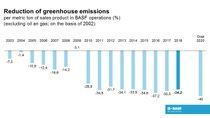Who we are
Transparent targets
When it comes to emissions, less is more – namely more environmental protection. And that is why BASF has been setting itself increasingly ambitious goals in this area since 2003. Their publication was a quantum leap in transparency!
BASF voluntarily set itself an array of ambitious environmental and safety targets for the first time in 2003 (on the basis of 2002) – which were also global and precisely defined. This was the crucial difference to the environmental and safety goals that had been published from 1997, which were mostly of a qualitative nature and only defined for individual sites.
When it comes to transparency, the publication of globally valid, measurable and verifiable environmental and safety targets was a real paradigm shift in BASF’s sustainable development.
“Walk the talk!” In keeping with this slogan, BASF has since assessed the degree to which it has achieved the goals it sets itself through its annual reporting. In doing so, it documented that it is following up its commitment to sustainable development with real action.
BASF achieved a number of successes: It achieved its targeted 10% reduction in greenhouse gas emissions per metric ton of sales product as early as 2007 – five years earlier than planned. In the following year (2008), the company therefore set itself new and ambitious targets for 2020. Because BASF views energy efficiency as a tool for linking climate protection, resource conservation and economic benefit, in 2008 it also set itself a quantitative target for increasing energy efficiency for the first time: This was to be increased by 25% (compared to 2002) by 2020.
In 2012, BASF once again set itself new and ambitious goals after achieving the changes targeted for 2020 in both areas (greenhouse gas emissions per metric ton of sales product and energy efficiency) as early as 2010 and 2011 respectively. Its energy efficiency was to be increased by 35% worldwide (up from the previous target of 25%), while greenhouse gas emissions were to be reduced by 40% (previously 25%). Since 2019, BASF has been pursuing its new objective of CO2-neutral growth by 2030.
While BASF formulated its first quantitative environmental and safety targets in 2003, economic goals have an even longer tradition at the company. With the 2003 corporate report, the company also published objectives relating to social responsibility for the first time. The first targets included an increase in the share of non-German senior executives and of female senior executives, as well as setting up an employee hotline for working and social standards.
As a Global Compact LEAD company, BASF contributes to the implementation of the 2030 Agenda for Sustainable Development of the United Nations agreed in 2015 and the associated Sustainable Development Goals (SDGs).
